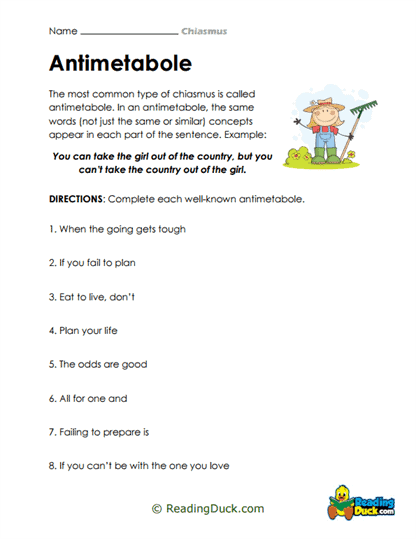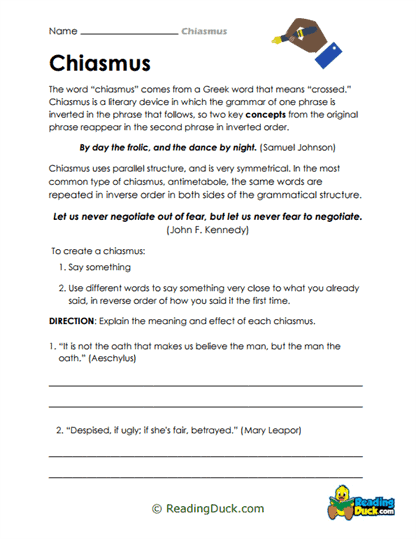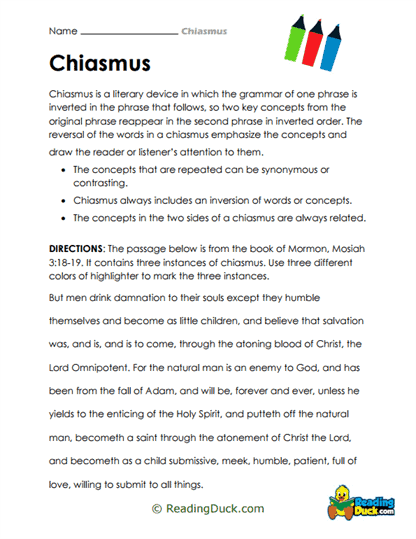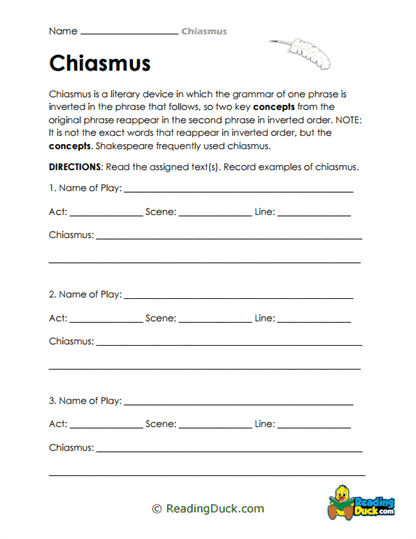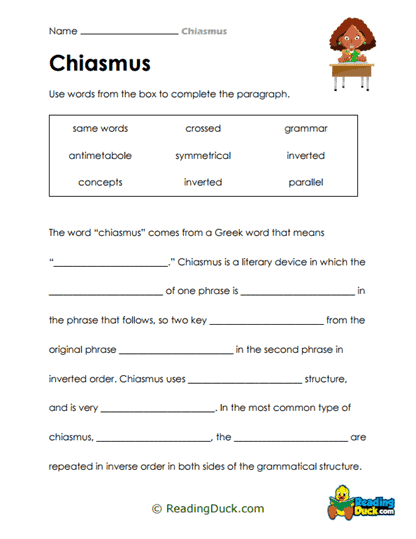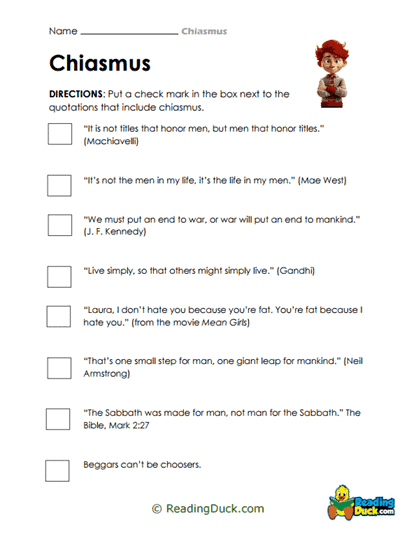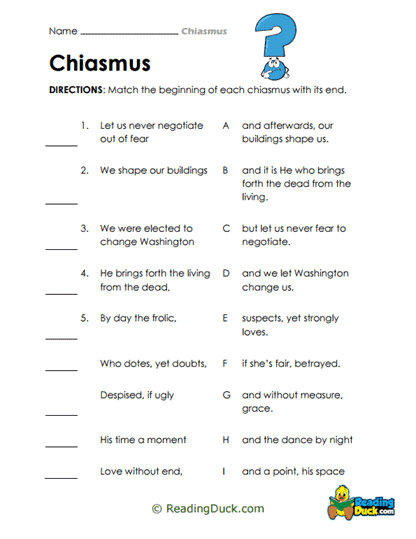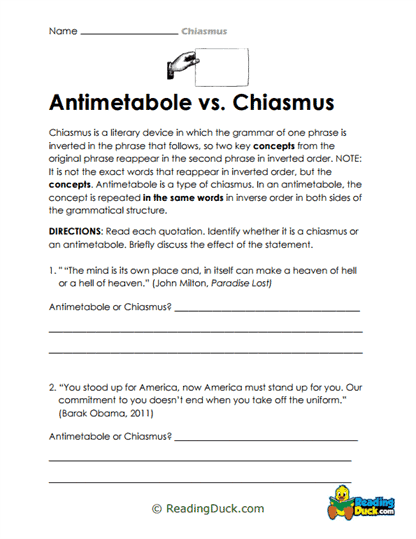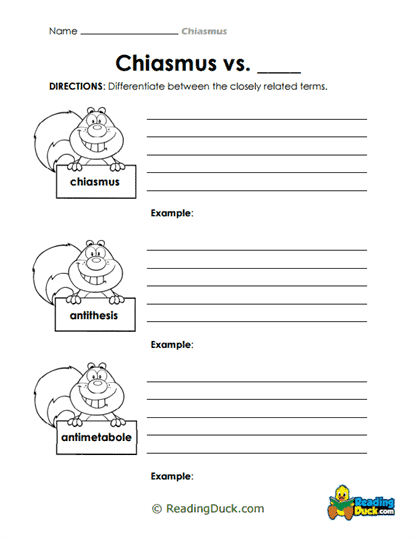Chiasmus Worksheets
About Our Chiasmus Worksheets
Our collection of Chiasmus Worksheets falls within the Language category under the Skills section. Designed to enhance students’ understanding of language and rhetoric, these worksheets aim to build mastery over the construction and use of chiasmus, a key rhetorical device.
Through a series of structured exercises, students can develop their ability to recognize, create, and employ this stylistic tool effectively, thereby improving their linguistic abilities. This collection not only assists with language comprehension but also bolsters writing, speaking, and analytical thinking skills. The worksheets are provided in PDF format, allowing users to easily access, download, and print them. Each worksheet is accompanied by a downloadable answer key, offering convenience and making self-guided learning or instructional support more efficient.
What Is Chiasmus?
Chiasmus is a rhetorical device used to create symmetry within language. It involves reversing the structure of words or phrases to produce a mirrored effect, often leading to a more impactful or memorable statement. This technique has been employed for centuries in various forms of literature, speeches, and writing. Let’s break down this concept and its various components.
Defining Chiasmus
Chiasmus can be understood as the repetition of concepts, words, or grammatical structures, but in reverse order. A typical chiasmus follows the AB-BA pattern, where elements introduced in one order are repeated in reverse.
For example:
- "Ask not what your country can do for you—ask what you can do for your country." (John F. Kennedy)
- "She has all my love; my heart belongs to her."
In both examples, the key terms are flipped in structure, creating a mirror-like pattern that emphasizes the point being made.
Components of Chiasmus
- Reversal of Structure: The hallmark of chiasmus is the reversal of word order. This structure often produces a sense of balance or symmetry in the sentence, which can make the statement more resonant and poetic.
- Contrasting or Complementary Ideas: While chiasmus often juxtaposes two ideas, it can also draw attention to complementary ideas, where both halves of the structure complete or enhance each other’s meaning.
- Memorability and Impact: The mirroring effect in chiasmus often makes the statement more memorable. This is why it is frequently used in speeches, literature, and even advertising to create a lasting impression.
Examples in Literature and Everyday Speech
- "Fair is foul, and foul is fair." (Shakespeare, Macbeth)
- "It’s not the size of the dog in the fight; it’s the size of the fight in the dog." (Mark Twain)
In these examples, chiasmus brings attention to the parallel ideas and emphasizes the contrast or relationship between them.
The Origins and Characteristics of Chiasmus
Chiasmus has a long-standing presence in the history of rhetoric and literature, with its roots tracing back to ancient Greek and Roman traditions. The term “chiasmus” comes from the Greek letter “χ” (chi), signifying a crossing or diagonal arrangement, which mirrors the structural cross of ideas that chiasmus creates.
Historical Background
- Greek and Roman Rhetoric: Chiasmus was first identified as a rhetorical tool in ancient Greece. Greek orators, philosophers, and poets used this technique to enhance the persuasiveness and artistic quality of their speech. Later, Roman orators such as Cicero also employed chiasmus in public speaking to make their messages more compelling.
- Religious Texts: Chiasmus is prevalent in religious texts, including the Bible, where its symmetrical structure often serves to highlight moral teachings or contrasts between divine principles.
- Modern Usage: In modern language, chiasmus continues to be an effective rhetorical device in speeches, poetry, and advertising slogans, often used to create a memorable turn of phrase.
Key Characteristics
- Symmetry: One of the most defining characteristics of chiasmus is its inherent symmetry, which creates balance within a sentence or statement. This symmetry appeals to readers and listeners, making the content easier to remember and understand.
- Clarity through Contrast: Chiasmus is often used to juxtapose opposing ideas, clarifying a point through contrast. This is particularly effective in persuasive writing or speeches, where the goal is to highlight a strong difference or reversal of perspective.
- Elevated Language: The use of chiasmus often brings an elevated tone to a piece of writing or speech, giving it a formal or poetic quality.
Chiasmus and Its Role in Literacy Development
Chiasmus plays a significant role in developing students’ literacy skills, especially in terms of reading, writing, and speaking. As a rhetorical device, it challenges students to think critically about word order, sentence structure, and the relationships between ideas. This deepens their understanding of how language can be used creatively and persuasively.
Enhancing Reading Skills
When students encounter chiasmus in literature or other texts, they learn to identify patterns and relationships between words. This fosters greater attention to detail and encourages students to analyze text structure and meaning more carefully. Understanding chiasmus helps students interpret complex language, making them more proficient readers.
Developing Writing and Speaking Abilities
By mastering the use of chiasmus, students enhance their ability to craft more sophisticated and impactful sentences. This skill can be particularly beneficial in writing essays, crafting persuasive arguments, and delivering speeches. Chiasmus teaches students to structure their thoughts clearly and present ideas in a compelling, memorable way.
Strengthening Analytical Thinking
Chiasmus also encourages critical thinking. In identifying or creating a chiasmic structure, students must analyze the relationship between words and ideas, fostering a deeper understanding of language and its nuances. This skill extends beyond language arts, supporting analytical thinking in other subjects as well.
Supplementary Activities for Reinforcing Chiasmus Learning
To further reinforce the concepts taught in the chiasmus worksheets, educators can introduce additional activities that help students practice and apply what they’ve learned. These activities can be used both in the classroom and in homeschool settings, and they can be adapted for various grade levels.
Classroom Activities
- Chiasmus Challenge: Have students work in pairs or small groups to create their own chiasmic sentences. Afterward, they can present their sentences to the class and explain the reversal of ideas or structure. This activity can be adapted for students in grades 5 through 12.
- Literary Scavenger Hunt: Assign students to find examples of chiasmus in books, speeches, or poems. They can then share their findings with the class, encouraging peer learning and deeper exploration of the concept. Suitable for middle school and high school students.
Homeschool Activities
- Chiasmus Journaling: For homeschoolers, journaling can be an excellent way to practice chiasmus. Each day, students can write one or two sentences using this device, reflecting on various topics. This encourages independent practice and reinforces their understanding.
- Flashcard Practice: Create flashcards with famous examples of chiasmus on one side and explanations on the other. Students can quiz themselves or a partner, strengthening their recall and recognition of the rhetorical structure.
The Practical Importance of Chiasmus for Students
In summary, chiasmus is a valuable language tool that strengthens students’ literacy skills and enhances their ability to think critically and creatively. Whether used in writing or speech, chiasmus promotes clarity, elegance, and memorability, making it a crucial rhetorical device for students to master.
By learning chiasmus, students not only improve their understanding of language mechanics but also develop skills that are applicable in real-world settings. Whether delivering a persuasive argument, writing a compelling essay, or simply striving for clear communication, the ability to use chiasmus effectively can greatly enhance a student’s overall language proficiency.
Ultimately, the practical importance of chiasmus lies in its ability to sharpen students’ rhetorical and linguistic abilities, equipping them with the tools they need to excel in academic and professional environments alike.
